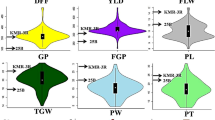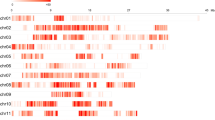Abstract
The future of rice breeding will likely be built on the basis of the further utilization of heterosis between elite cultivars and genetic resources from distant subspecies of rice. Previous studies have proved that exogenous genomic DNA transformation methods can be used to transfer genetic information from distant relatives (donor) into cultivated rice (recipient). However, the mechanism underlying this form of genetic transfer is poorly characterized, and the genes that cause the phenotypic changes in these variants are typically difficult to identify. This study examined YVB, a stable variant line with greatly improved grain quality traits that was derived from an indica variety (V20B) by transferring genomic DNA of O.minuta through the “spike-stalk injection method (SIM)”. We used restriction-site associated DNA sequencing technology (RAD-seq) to evaluate a population of BC1F5 backcross lines (YVB × V20B); the RAD-seq data were used to construct a genetic linkage map with high-density SNPs for use in association analysis exploring genotype–phenotype relationships at the whole-genome level. A total of 17 quantitative trait loci (QTLs) for rice quality traits were mapped to chromosomes 3, 5, 6, 8, and 9. 8 major QTLs controlling different phenotypic variations were mapped to the same region of chromosome 5. This region contained the GS5 gene for grain weight and the qSW5/GW5 gene for grain width. This study provides new resources and insights into the molecular mechanisms of grain trait phenotypic variation and the transmission of genetic information via the introduction of genomic DNA to a distantly related crop relative species.






Similar content being viewed by others
Abbreviations
- RAD-seq:
-
Restriction site-associated DNA sequencing
- SNP:
-
Single nucleotide polymorphism
- InDel:
-
Insertion and deletion
- QTL:
-
Quantitative trait loci
- SIM:
-
Spike-stalk injection method
- NGS:
-
Next-generation sequencing techniques
- SSR:
-
Simple sequence repeat
- RFLP:
-
Restriction fragment length polymorphism
- TGW:
-
Thousand-grain weight
- GL:
-
Grain length
- GW:
-
Grain width
- LWR:
-
Length/width ratio
- MR:
-
Milled rice ratio
- HR:
-
Head rice ratio
- CA:
-
Chalkiness area
- CR:
-
Chalkiness rate
- AC:
-
Amylose content
- GC:
-
Gel consistency
References
Aluko G, Martinez C, Tohme J, Castano C, Bergman C, Oard JH (2004) QTL mapping of grain quality traits from the interspecific cross Oryza sativa x O. glaberrima. Theor Appl Genet 109:630–639
Baird NA, Etter PD, Atwood TS, Currey MC, Shiver AL, Lewis ZA, Selker EU, Cresko WA, Johnson EA (2008) Rapid SNP discovery and genetic mapping using sequenced RAD markers. PLoS One 3(10):e3376
Bao JS, Sun M, Corke H (2002) Analysis of genetic behavior of some starch properties in indica rice (Oryza sativa L.): thermal properties, gel texture, swelling volume. Theor Appl Genet 104:408–413
Davey JW, Hohenlohe PA, Etter PD, Boone JQ, Catchen JM, Blaxter ML (2011) Genome-wide genetic marker discovery and genotyping using next generation sequencing. Nat Rev Genet 12:499–510
Dong YJ, Tsuzuki E, Kamiunten H, Terao H, Lin DZ (2001) Molecular mapping of QTLs for hulled-rice shape using recombinant inbred population. Oryza 38:9–12
Dong YJ, Tsuzuki E, Lin DZ, Kamiunten H, Terao H, Matsuo M, Cheng S (2004) Molecular genetic mapping of quantitative trait loci for milling quality in rice (Oryza sativa L.). J Cereal Sci 40:109–114
Duan MJ, Sun ZZ, Shu LP, Tan YN, Yu D, Sun XW et al (2013) Genetic analysis of an elite super-hybrid rice parent using high-density SNP markers. Rice (N Y) 6:21
He GC, Blackhall N, Davey MR (1998) Protoplast fusion of cultivated rice (Oryza sativa L) to four wild Oryza species. Plant Sci J 16:11–17
He P, Li SG, Qian Q, Ma YQ, Li JZ, Wang WM et al (1999) Genetic analysis of rice grain quality. Theor Appl Genet 98:502–508
Hu YY, Mao BG, Peng Y, Sun YD, Pan YL, Xia YM et al (2014) Deep re-sequencing of a widely used maintainer line of hybrid rice for discovery of DNA polymorphisms and evaluation of genetic diversity. Mol Genet Genomics 289(3):303–315
Huang XH, Feng Q, Qian Q, Zhao Q, Wang L, Wang AH et al (2009) High-throughput genotyping by whole-genome Resequencing. Genome Res 19:1068–1076
Isshiki M, Morino K, Nakajima M, Okagaki RJ, Wessler SR, Izawa T et al (1998) A naturally occurring functional allele of the rice waxy locus has a GT to TT mutation at the 5′ splice site of the first intron. Plant J 15:133–138
Li R, Yu C, Li Y, Lam TW, Yiu SM, Kristiansen K et al (2009) SOAP2: an improved ultrafast tool for short read alignment. Bioinform 25:1966–1967
Li YB, Fan CC, Xing YZ, Jiang YH, Luo LJ, Sun L et al (2011) Natural variation in GS5 plays an important role in regulating grain size and yield in rice. Nat Genet 43:1266–1269
Mariam AL, Zakri AH, Mahani MC, Normah MN, Mariam AL (1996) Interspecific hybridization of cultivated rice, Oryza sativa L. with the wild rice, O.minuta. Presl. Theor Appl Genet 93:664–671
Pena DL, Lorz H, Schell J (1987) Transgenic rye plant obtained by injecting DNA into young floral tillers. Nature 325:274–276
Pervaiz ZH, Rabbani MA, Khaliq I, Pearce SR, Malik SA (2010) Genetic diversity associated with agronomic traits using microsatellite markers in pakistani rice landraces. Electron J Biotechnol 13:2182–2185
Pfender WF, Saha MC, Johnson EA, Slabaugh MB (2011) Mapping with RAD (restriction-site associated DNA) markers to rapidly identify QTL for stem rust resistance in Lolium perenne. Theor Appl Genet 122:1467–1480
Redoña ED, Mackill DJ (1998) Quantitative trait locus analysis for rice panicle and grain characteristics. Theor Appl Genet 96:957–963
Septiningsih EM, Trijatmiko KR, Moeljopawiro S, McCouch SR (2003) Identification of quantitative trait loci for grain quality in an advanced backcross population derived from the Oryza sativa variety IR64 and the wild relative O. rufipogon. Theor Appl Genet 107:1433–1441
Shomura A, Izawa T, Ebana K, Ebitani T, Kanegae H, Konishi S, Yano M (2008) Deletion in a gene associated with grain size increased yields during rice domestication. Nat Genet 40:1023–1028
Tan YF, Li JX, Yu SB, Xing YZ, Xu CG, Zhang Q (1999) The three important traits for cooking and eating quality of rice grains are controlled by a single locus in an elite rice hybrid, Shanyou 63. Theor Appl Genet 99:642–648
Wan XY, Wan JM, Weng JF, Jiang L, Bi JC, Wang CM et al (2005) Stability of QTLs for rice grain dimension and endosperm chalkiness characteristics across eight environments. Theor Appl Genet 110:1334–1346
Wang N, Fang L, Xin H, Wang L, Li S (2012) Construction of a high-density genetic map for grape using next generation restriction-site associated DNA sequencing. BMC Plant Biol 12:148
Weng J, Gu S, Wan X, Gao H, Guo T, Su N et al (2008) Isolation and initial characterization of GW5, a major QTL associated with rice grain width and weight. Cell Res 18:1199–1209
Xing Q, Zhao B, Xu K, Yang K, Liu X, Wang S et al (2004) Test of agronomical characters and amplified fragment length polymorphism analysis of new rice germplasm developed from transformation of genomic DNA of distant relatives. Plant Mol Biol Rep 22:155–164
Yan CQ, Qian KX, Yan QS, Zhang XQ, Xue GP, Huangfu WG et al (2004) Use of asymmetric somatic hybridization for transfer of the bacterial blight resistance trait from Oryza meyeriana L. to O. sativa L. ssp. japonica. Plant Cell Rep 22:569–575
Zhao BR, Xing QH, Xia HA, Yang HH, Jin DM, Liu X et al (2005) DNA Polymorphism among Yewei B, V20B and Oryza minuta J. S. Presl. ex CB Presl. J Integr Plant Biol 47:1485–1492
Zhou G, Weng J, Zeng Y, Huang J, Qian S, Liu G (1983) Introduction of exogenous DNA into cotton embryos. Method Enzymol 101:433–481
Zhou Z, Robards K, Helliwell S, Blanchard C (2002) Composition and functional properties of rice. Int J Food Sci Technol 37:849–868
Acknowledgments
We thank Zhicheng Yuan, Chengshu Zhou, and Wuzhong Luo of the China National Hybrid Rice Research and Development Center for the management of our field plantings. This research was financially supported by the National Natural Science Foundation of China (31471465; 31301291; 31501289) and the earmarked fund for Modern Agro-industry Technology Research Systems (CARS-01-05).
Author information
Authors and Affiliations
Corresponding authors
Ethics declarations
Conflict of interest
The authors declare that they have no conflict of interest.
Ethical standards
The experiments complied with the current laws of the country in which they were performed.
Additional information
Communicated by B. Yang.
Y. Peng and Y. Hu have contributed equally to this work.
Electronic supplementary material
Below is the link to the electronic supplementary material.
438_2015_1104_MOESM3_ESM.doc
Supplementary material Table S1. Statistics of the sequencing data, unique coverage, and sequencing depth for the 100 BC1F5 lines (DOC 147 kb)
438_2015_1104_MOESM4_ESM.doc
Supplementary material Table S2. Detection and annotation of the SNPs and InDels in V20B, YVB, and O.minuta for the qSW5, GS5, Wx, GW8, ALK, and Chalk5 genes (DOC 40 kb)
Rights and permissions
About this article
Cite this article
Peng, Y., Hu, Y., Mao, B. et al. Genetic analysis for rice grain quality traits in the YVB stable variant line using RAD-seq. Mol Genet Genomics 291, 297–307 (2016). https://doi.org/10.1007/s00438-015-1104-9
Received:
Accepted:
Published:
Issue Date:
DOI: https://doi.org/10.1007/s00438-015-1104-9




